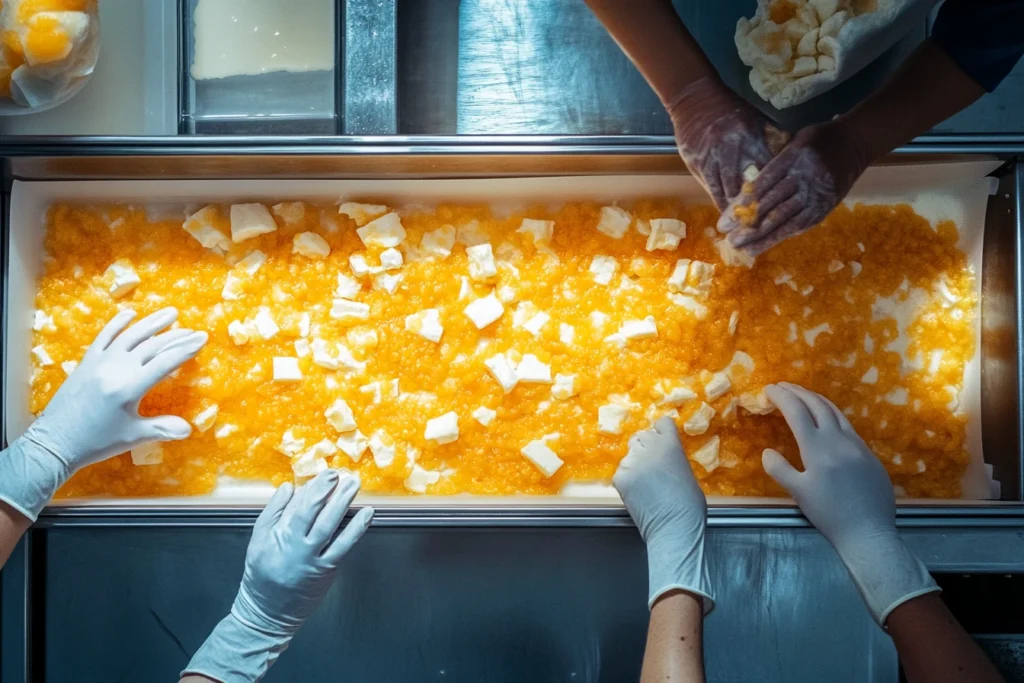1. Introduction to Colby Jack Cheese
Colby Jack cheese, moreover known as Co-Jack, is a delightful combination of Colby and Monterey Jack cheeses. Cherished for its gentle flavor and rich surface, it is a flexible cheese that complements a wide assortment of dishes.
Originating in the United States, this marbled cheese has ended up a staple in American family units, especially for sandwiches, casseroles, and snacks. Its particular orange-and-white appearance makes it outwardly engaging, whereas its capacity to dissolve easily includes to its culinary notoriety.
This article explores everything almost Colby Jack cheese from its history and generation handle to formulas, wholesome esteem, and capacity tips.
2. What Is Colby Jack Cheese?
Colby Jack cheese is a marbled mix of two American favorites: Colby cheese and Monterey Jack cheese. It combines the gentle, buttery flavor of Monterey Jack with the marginally tart and nutty taste of Colby, coming about in a flexible cheese with a semi-soft texture.
2.1 Definition and Origin
It is a product of American ingenuity, originating in the early 20th century in the dairy-rich state of Wisconsin. Colby cheese, named after the town of Colby, Wisconsin, was first created in 1885, while Monterey Jack traces its roots to California. The combination of these two cheeses produced a marbled blend that has since gained immense popularity.
The cheese is celebrated for its special look—a blend of orange Colby and rich white Monterey Jack—and its capacity to cater to different formulas and inclinations. Learn more almost its history and generation at Wisconsin Cheese.
2.2 Flavor and Texture
It offers a gentle, rich flavor with insights of tanginess from the Colby component. The surface is semi-soft, making it simple to cut, shred, or soften. It’s especially well known in dishes that require a smooth, melty consistency, such as barbecued cheese sandwiches, nachos, and casseroles.
This cheese is often preferred for its versatility, as it appeals to both kids and adults. Its approachable flavor profile makes it a favorite for family meals and snack platters.
3. How Is Colby Jack Cheese Made?
Producers utilize a direct however carefully controlled handle to make Colby Jack cheese, guaranteeing its signature marbled appearance and velvety surface. This prepare mixes Colby and Monterey Jack cheeses, coming about in a flavorful and flexible item.
3.1 Ingredients
The primary ingredients in it include:
- Pasteurized cow’s milk
- Cheese cultures
- Rennet for curdling
- Salt for flavor and preservation
Cheesemakers often add optional ingredients, such as annatto, to give Colby its orange hue and create the marbled effect when combined with white Monterey Jack cheese.
3.2 Production Process

- Milk Preparation: The process begins by pasteurizing the milk to eliminate harmful bacteria.
- Culturing and Curdling: Starter cultures and rennet are added to the milk, allowing it to curdle and form curds.
- Cutting and Cooking: The curds are cut into small pieces and gently cooked to remove excess moisture.
- Draining and Washing: After cooking, the whey is depleted, and the curds are washed to decrease sharpness, giving the cheese its mellow flavor.
- Blending and Molding: Colby and Monterey Jack curds are mixed together to create the marbled effect. The mixture is then pressed into molds to shape the cheese.
- Aging: The molded cheese is aged for two to four weeks, allowing the flavors to develop while maintaining a creamy texture.
3.3 Aging Process
It is aged for a relatively short period, usually between two and four weeks. This short aging time preserves its mild flavor and smooth texture, making it ideal for melting and slicing.
Longer-aged adaptations create a somewhat more honed taste, but the larger part of Colby Jack accessible in stores keeps up its delicate and gentle profile.
4. Nutritional Profile of Colby Jack Cheese
It is not only delicious but also provides a range of nutrients that make it a valuable addition to a balanced diet. Its protein and calcium content support muscle growth and bone health, while its fats provide energy.
4.1 Macronutrients
A typical one-ounce serving contains:
- Calories: Approximately 100–110 calories
- Protein: Around 6–7 grams, supporting muscle repair and growth
- Fat: About 9–10 grams, with a mix of saturated and unsaturated fats
- Carbohydrates: Less than 1 gram, making it a low-carb option
This nutritional breakdown makes it suitable for those following high-protein or low-carb diets.
4.2 Vitamins and Minerals
It offers several important vitamins and minerals, including:
- Calcium: Promotes strong bones and teeth, with about 200 milligrams per serving
- Phosphorus: Supports energy metabolism and bone health
- Vitamin A: Essential for vision and immune function
- Zinc and Vitamin B12: Aid in cell repair and energy production
While it’s rich in essential nutrients, it should be consumed in moderation due to its sodium content.
4.3 Health Considerations
Benefits:
- Provides high-quality protein and calcium for bone and muscle health
- Low in carbs, making it suitable for ketogenic and low-carb diets
- Contains conjugated linoleic acid (CLA), which may support weight loss and reduce inflammation
Drawbacks:
- Contains saturated fats that should be limited for heart health
- High sodium levels may not be suitable for individuals managing blood pressure
5. Culinary Uses of Colby Jack Cheese
Colby Jack cheese is highly versatile, making it a favorite ingredient in kitchens worldwide. Its creamy texture and mild flavor allow it to complement a wide range of dishes, whether served hot or cold.
5.1 Melting and Cooking Applications

It is widely known for its excellent melting properties, making it ideal for warm, gooey recipes.
Popular Uses:
- Grilled Cheese Sandwiches: Creates a rich, melty filling perfect for quick meals.
- Quesadillas and Tacos: Melts easily, adding a creamy texture to Mexican dishes.
- Casseroles and Pasta Bakes: Blends seamlessly into sauces for creamy, baked comfort foods.
- Soups and Dips: Enhances flavor in creamy soups and adds richness to cheese dips.
Its capacity to soften equally without getting to be sleek or stringy makes it one of the most flexible cheeses for hot dishes.
5.2 Snack and Serving Ideas
Pair Colby Jack cheese with crackers, fruits, or deli meats for quick snacks. It also pairs well with baked sides like Southern Cornbread Recipe, offering a comforting and delicious combination for meals or gatherings.
Quick Serving Suggestions:
- Slice it and pair with crackers and fresh fruit for a quick snack platter.
- Add cubes to salads for extra flavor and protein.
- Serve with grapes, apples, and nuts on a cheese board for parties.
- Cut into sticks for easy, kid-friendly snacks.
5.3 Pairing with Beverages
While it complements most beverages, pairing it with the right drink enhances the overall experience.
Recommended Pairings:
- Sparkling Water or Lemonade: Refreshing and light, ideal for daytime snacks.
- Iced Tea: Balances the mild flavor of the cheese without overpowering it.
- Ciders or Light Beers: Complements its creamy texture for casual meals.
These options make it suitable for pairing with various foods and drinks, offering flexibility for any occasion.
6. Storage and Shelf Life of Colby Jack Cheese
Proper storage of Colby Jack cheese preserves its flavor and texture, allowing it to remain fresh for weeks. Following the right storage methods also prevents spoilage and extends its usability.
6.1 Proper Storage Methods
To maintain freshness, store Colby Jack cheese in an airtight container or wrap it in wax paper before sealing it in plastic wrap. This method prevents moisture loss and protects it from absorbing odors in the refrigerator.
When storing pre-shredded versions, keep the cheese in its original resealable bag or transfer it to an airtight container to prevent it from drying out. For short-term storage, place it in the refrigerator at a temperature between 34°F and 40°F.
6.2 Shelf Life
It typically stays fresh for three to four weeks when refrigerated properly. If freezing is required, wrap the cheese tightly in plastic wrap and store it in a freezer-safe bag. Freezing preserves it for up to six months, but it may slightly alter the texture, making it more suitable for melting or cooking after thawing.
When using frozen cheese, allow it to thaw in the refrigerator overnight before adding it to recipes.
7. Popular Varieties and Alternatives
Colby Jack cheese offers variations that cater to different tastes and dietary needs. It also has close substitutes for those who want similar flavors and textures.
7.1 Varieties of Colby Jack Cheese
Colby Jack cheese comes in multiple forms, including block, sliced, shredded, and pre-packaged snack sticks. These variations make it convenient for cooking, snacking, and meal preparation.
Common Varieties:
- Sharp Colby Jack: Aged longer for a more robust flavor.
- Low-Fat and Reduced-Sodium Options: Ideal for those monitoring calorie or salt intake.
- Organic Varieties: Made from organic milk and free from artificial additives.
These options allow consumers to enjoy the cheese while accommodating different dietary preferences and health goals.
7.2 Similar Cheeses
For those who can’t find it or need an alternative, several cheeses provide comparable flavor and texture. Another alternative is Gruyere, which offers a rich, nutty flavor and works well in recipes like Gruyere Cheese Recipes.
Recommended Alternatives:
- Cheddar-Jack: A sharper variation with a stronger flavor, suitable for melting.
- Marble Cheese: A blended cheese similar in appearance, offering a mild taste.
- Monterey Jack: A softer, creamier alternative that works well in dips and sauces.
- Colby Cheese: Slightly firmer and tangier, providing a closer match in texture.
These substitutes can seamlessly replace Colby Jack in recipes, ensuring consistency in flavor and performance.
8. Benefits and Drawbacks of Colby Jack Cheese
Colby Jack cheese offers numerous nutritional and culinary benefits, but it also comes with a few drawbacks that should be considered, especially for those with dietary restrictions.
8.1 Benefits
High in Protein and Calcium:
Colby Jack cheese provides a rich source of protein, essential for muscle growth and repair. Its calcium content supports strong bones and teeth, making it a healthy addition to balanced diets.
Versatility in Cooking:
Its ability to melt easily and blend with other ingredients makes it ideal for casseroles, sandwiches, and snacks. It is equally enjoyable served cold on a charcuterie board or shredded into salads.
Low in Carbohydrates:
With minimal carbohydrates, it fits well into low-carb and ketogenic diets.
Kid-Friendly and Crowd-Pleasing:
Its mild flavor and creamy texture appeal to children and adults, making it a family favorite for meals and snacks.
8.2 Drawbacks
High Saturated Fat Content:
Although it contains healthy fats, it also has high levels of saturated fat. Excessive consumption may contribute to high cholesterol levels, which can affect heart health. Moderation is recommended.
Sodium Levels:
Like many cheeses, Colby Jack can be high in sodium, which may not be suitable for individuals with hypertension or those watching their salt intake. Reduced-sodium options provide a healthier alternative.
Lactose Content:
While it is lower in lactose than some dairy products, it may still cause discomfort for those with lactose intolerance. Lactose-free varieties may be a better choice for sensitive individuals.
9. Frequently Asked Questions (FAQs) About Colby Jack Cheese
9.1 What Does Colby Jack Cheese Taste Like?
Colby Jack cheese has a mild, buttery flavor with a slightly tangy undertone from the Colby portion. Its creamy texture makes it easy to slice, melt, or shred, making it a versatile option for many dishes.
9.2 Can Colby Jack Cheese Be Melted?
Yes, Colby Jack cheese melts beautifully. Its creamy texture allows it to blend seamlessly into sauces, casseroles, and grilled cheese sandwiches. It’s also great for nachos, pasta bakes, and dips.
9.3 Is Colby Jack Cheese Gluten-Free?
Naturally, Colby Jack cheese is gluten-free since it contains milk, cultures, rennet, and salt. However, individuals with gluten sensitivities should check labels on pre-shredded or flavored varieties to confirm they do not contain gluten-containing additives.
9.4 How Long Does Colby Jack Cheese Last in the Fridge?
When stored properly, Colby Jack cheese lasts about three to four weeks in the refrigerator. To extend its freshness, wrap it in wax paper or plastic wrap and store it in an airtight container.
9.5 Can Colby Jack Cheese Be Substituted?
Yes, several cheeses can substitute Colby Jack, including:
- Monterey Jack for a milder flavor.
- Cheddar for a sharper taste.
- Marble cheese for a similar marbled appearance and texture.
These options work well in recipes that call for Colby Jack cheese.
10. Conclusion
Colby Jack cheese stands out as a versatile, flavorful, and visually appealing option for both cooking and snacking. Its smooth, creamy texture and mild taste make it suitable for a variety of recipes, from casseroles and sandwiches to salads and cheese boards.
In addition to its culinary flexibility, it offers important nutrients like protein and calcium, supporting muscle and bone health. While it’s rich in flavor, it’s important to enjoy it in moderation due to its fat and sodium content.
Whether you’re a home cook experimenting with new recipes or someone who loves cheese boards, it is a delicious and practical addition to any kitchen.
